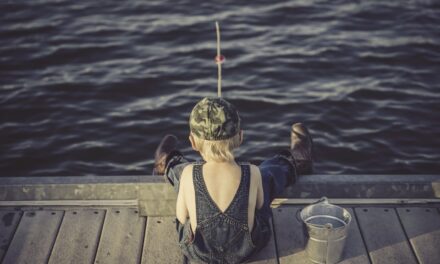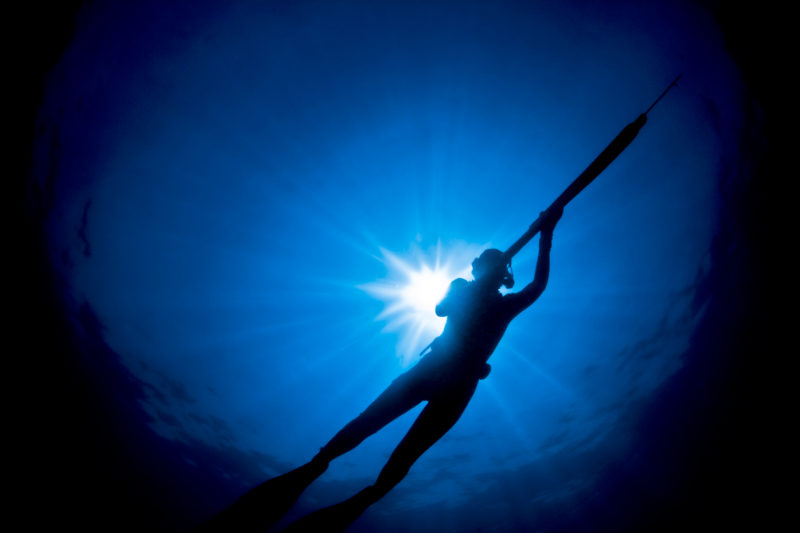What’s the best time to go spearfishing? Simply put, the best time to go spearfishing is the time when there’s plenty of fish. So we’ll look for the reasons why they would come close to the coast or favorite spearfishing spot, and why they would go back to deeper waters or even migrate to a different place.
Generally speaking, fish like mildly cool water, they would come after the bait, high and low tide pushes them back into the sea, and they have migration and mating patterns that are also related to temperature, food, and water currents.
Since we do not have the luxury to go fishing all year around, it would be wise to know when and where to find our favorite fish. Luckily the behavior of fish is somewhat predictable. There’s a lot still left to luck though, which makes the sport exciting.
The old fishing folk will tell you things like ‘you’ll see sea bass when this tree blossoms’. And traditional pearls of wisdom like that are rarely wrong! It’s good to get a feel of the local scene and talk to the residents in the fishing spot you chose for this season. This, of course, is not an alternative to scientific observations of the marine life over there.
The following factors have a significant effect on the behavior of fish:
Factors Affecting Fish Behavior
Temperature
Fish are cold-blooded animals, so they get their body temperature from their surroundings. Temperature affects the whole existence of fish, their feeding, reproduction, migration, and overall activity.
When it comes to fish’s optimal temperature, biology says that there is no one size fits all. Each type of fish has a sweet spot preset by its genetic code. So, for example, Lake Trout favors temperatures from 42-55 degrees, while Largemouth Bass prefers 60-77 degrees.
In summer, warm water fish can be caught in the shallow waters, while cold water fish would rather chill in the cool water much deeper in the sea.
In winter, the warm water fish will either hibernate or migrate to warmer waters, so looking for it in the same place you found it in summer would be a fool’s errand.
The cold water fish will bear the frosty cold season, and then it will surface briefly during spring, ready and eager to eat, till the warmth of the returning summer pushes it back to cooler water.
Some fish are more flexible, and their behavior is a mixture of the above-mentioned types. They survive impressively at ease with the changing seasons. So if you’re planning a fishing trip, you might want to target this variety. The odds of catching them are higher.
The rate of change of temperature is also of importance. So a sudden decrease or a very rapid drop in temperature sends the fish right off the feed.
The temperature during the warm months also varies throughout the depth of the water. They are warm till about 15 feet down, then the water becomes cold, and develops what is known as a ‘thermocline’. The oxygen in the water is abundant where the warm and cold layers meet, and this attracts plenty of fish.
Tides and Currents
Tides are lovely phenomena that never cease to amaze me. I must have seen the ebb and flow of water a thousand times, but they are still worth watching. They are also worth following if you want to catch fish.
Fishermen have noticed since ancient times that at certain points in the moon cycle, fish are abundant and easy to catch. Tides cause water currents, these bring in food from various places in the sea, and naturally, the fish follow the food.
Tides are dependant on the moon and to a lesser degree sun gravity. When both forces align we get strong tides, and when they oppose the reverse happens.
Mid tide, or the time between the high and low tide, is the best time to catch fish. This seems very high precision, but it actually becomes second nature to seasoned fishermen. It’s a lot like playing by ear.
As the tide recedes, some natural structures intercept the fish, and these become amazing fishing spots. So the tide can be used outside the usual mid-tide openings, depending on other factors like man-made structures (harbors) or the creative sculptures of nature (channels, alcoves).
Tides do not only affect the shallow part of the sea, but they also affect the fish activity in the deep sea. Two types of current are at play here: eddy currents and upwellings. Both wash up small sea creatures and plants, thus creating points of attraction for bigger fish.
Moon Cycle and Bite Time
At certain times in the moon cycle, fish become overly enthusiastic to eat. Pinpointing the times and places of such feeding peaks can make a fisherman very happy.
These times are generally marked by the full moon and the new moon. Four days after each of these moon phases usually gives good results.
I’m not very clever with these moon phase markings, but I’m a bit reassured with the locals’ thorough understanding of how it works! Seamen have very sharp instincts with that kind of stuff!
Weather Conditions
From all the raging elements; rain is the least troublesome when it comes to spearfishing. In some places, lightning is a huge issue, and it could be an outright safety hazard.
The weather condition that has the most impact is wind. Both the intensity of the wind and its direction play important roles in fish behavior. A strong wing could easily turn the water, and as it becomes muddy, catching fish becomes almost impossible, plus the fish itself recedes to the deeper and less turbulent waters.
Doing spearfishing from a boat also becomes a bit problematic in strong winds, as the swimmer and the boat drift quickly and cover large distances in a short time. This is obviously not an ideal situation for good sport.
This is one of the main reasons winter and fall seasons aren’t very popular as spearfishing seasons, despite the availability or even abundance of certain types of fish at these times.
So what is the best time to go spearfishing?
Best season
All seasons can be good seasons, it all depends on what you have in mind!
Summer is generally agreed to be THE fishing season. However, there’s no one best season for all fish types. It depends on what you want to catch, there are of course some logistics to consider as well.
Summer will attract warm-water types like Northern Pike, Crappie, and Largemouth Bass. summer has an extra benefit over the other seasons in that the weather is generally good, so no wind, rain, or lightening trouble. Also, the mild temperature reduces the need for special gear like a thick wetsuit.
Winter will have an abundance of cold water species Lake Trout and Coho Salmon. They can be found during the other seasons but in much deeper water. Fishing in winter comes with more concerns though, like how to stay warm during the frost, how to avoid the tough weather spells and the effect of wind on the water and its fish.
In spring and fall, cool water fish will abound, so you could easily find Walleye and Rainbow Trout. Again these seasons could come with some undesirable weather conditions, so checking the forecast is always wise.
Best time of the month
The times during the month that carry the most promise are the full moon, new moon, first quarter, and third quarter. This when the fish come out of their hiding places and congregate to feed. It’s clearly easier to spot and catch them at these times.
You don’t need to be an astronomer to get these times right, the great news is that there are charts online that mark these interesting times. All you have to do is plan your fishing expedition around these times.
There’s also the thing about spearfishing at night: It is hard, and only the pros can handle it. The full moon, however, provides a good enough light to spot and target the fish.
Best time of the day
Sunset and sunrise are considered the best of times of day to catch fish. Also moonrise and moonset. Fish are usually active for about an hour and a half around these times. Luckily, even if the sky is overcast, they can be calculated and marked by readily available charts.
Daytime spearfishing is clearly the more common form of that sport, as sighting a fish is the way it gets targeted and caught.
Night spearfishing is a bit more challenging. For a sport dependent on eyesight, darkness tends to be very limiting. It is not impossible though, and it has its enthusiasts, who use a flashlight and other specialized gear to take on a nighttime hunt!
Timing is great, and so is good preparation and safety. So make a plan, get the right gear, stay with your group or partner, respect your limits, and understand that mother nature is a bit moody, and doesn’t always play by the book!



![A Guide To Freediving Gear [For The Beginner]](https://spearoscout.com/wp-content/uploads/2019/03/Spearfishing-freedivng-440x264.jpg)


